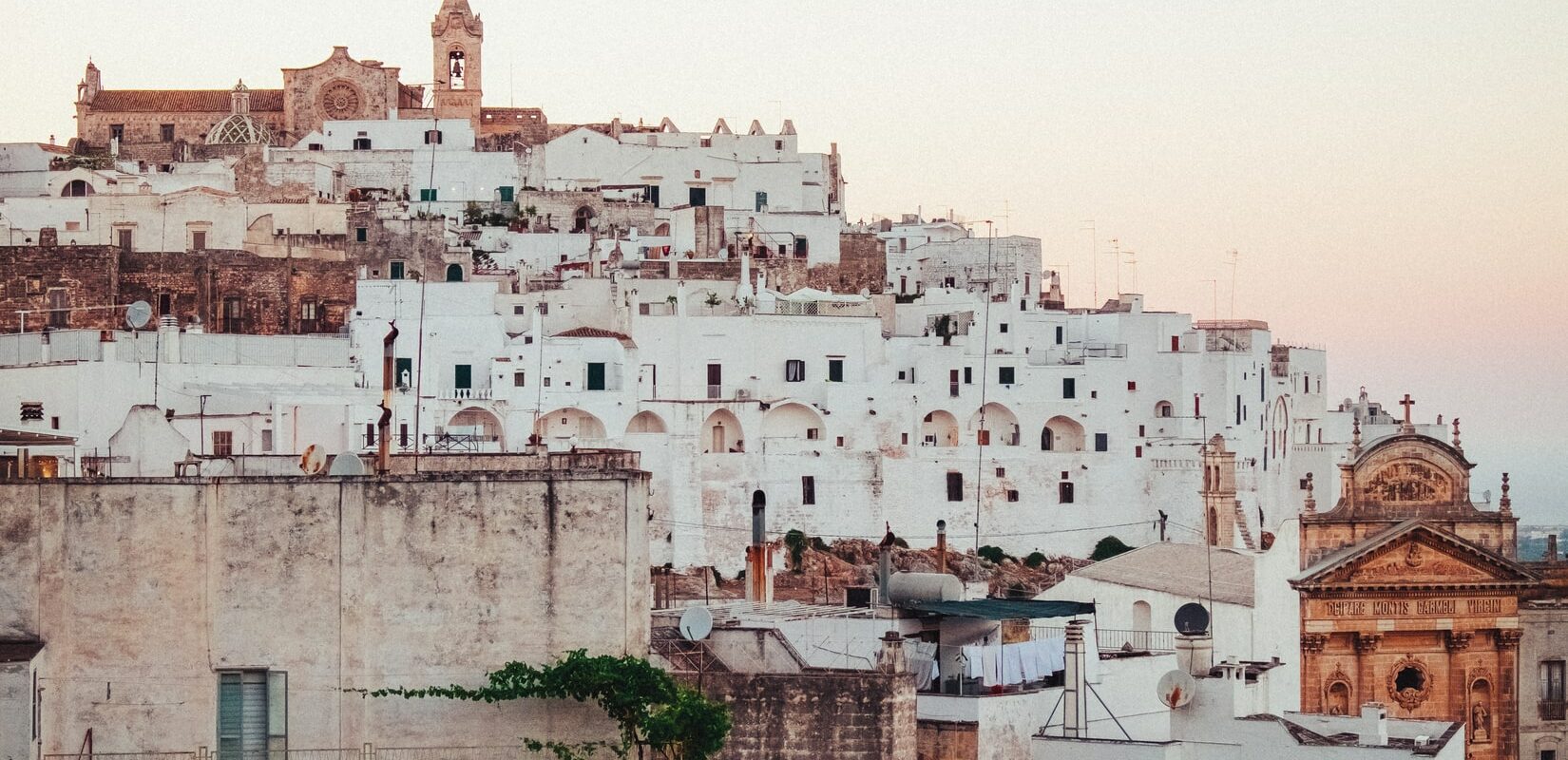
Ostuni
The beauty of this corner of the Mediterranean and the hospitality of its people can never be fully described except in the eyes of those who have experienced it.
A trip to Ostuni is therefore an appropriate and obligatory step to discover the beauty of the Gargano, its territory and the natural and cultural treasures of the white city. Blinding white is the color of the houses of this ancient village in the Murgia west of Brindisi. A tangle of alleys, reminiscent of a casbah, is gathered on the slopes of an undulating hill, whose original nucleus, located within the circle of Aragonese turreted bastions, is characteristic for its stepped alleys and archivolts. From the top it dominates the cathedral, while the more recent districts stretch out on the terraces of the Murgia. The typical gastronomy, the surrounding Mediterranean landscapes, the local customs and traditions have recreated a unique context in the world that can be easily discovered thanks to the travel offers to Ostuni.
The Municipality of Ostuni rises on the last offshoots of the southern Murgia. Its old city, called La Terra, is unmistakable by the blinding white monochrome of its town. The lime-painted houses and the peculiar topography have deserved fairytale epithets, such as the White City, the Queen of Olives, the Nativity City. The ancient core - probable support of the Messapian acropolis - is in fact perched on the steep sides of a hill and has an ellipsoidal plan, clearly expressed by the walls reinforced by the Aragonese towers. Today eight of the original fifteen remain, as well as good parts of the old bulwarks that closed the medieval city. Ostuni is a fascinating tangle of narrow and winding streets, a succession of courtyards, squares and alleys that once belonged to five doors that opened into the walls, equipped with towers, piombatoi and bertesche. The only real road that reaches the top of the "cone" and that divides the historic center into two parts, is via Cattedrale, while all the others that intersect it are dead ends or narrow and steep stairways. Here there are cubicular dwellings, often carved into the rock, joined by arches and semi-arches that act as buttresses and support, like palaces that, due to the noble coats of arms, the portals and the variety of architectural lines, shade the blinding glow of the white labyrinth. Finally, on the top of the hill, stands the Cathedral, an admirable synthesis of Romanesque, Gothic and Venetian elements, as well as the Bishop's Palace, which dominates the plain of centuries-old olive trees to the sea. The ancient village is the undisputed jewel that gives Ostuni its picturesque urban identity and must be visited at least once in a lifetime. The land is defined by the people of Ostuni.
The beautiful fifteenth-century Cathedral, dedicated to Santa Maria dell’Assunción, a national monument since 1902, which stands on the top of the highest hill in the white city, lies in the historic center of Ostuni. Renovated in the late fifteenth century, after a strong earthquake, the Cathedral has a majestic facade with three portals, surmounted by three rose windows, including the central one, a triumph of medieval symbolism, with 24 rays formed by columns and arches and the figure in the center. of Christ, surrounded by the apostles and seven heads of cherubs, holding the earth as a sign of protection. With a Latin cross shape, the interior of the church is divided into three naves separated by arches of 5 columns. The central nave has three beautiful eighteenth-century canvases, with scenes from the life of Jesus, set in the ceiling, and fascinating frescoes dedicated to the patron saint Sant’Oronzo and the martyrdom of San Biagio. Also not to be missed is the portal of the Church of the Holy Spirit, dating back to 1450, today recognized as a national monument.
Not to be missed is the Cavalcade of Sant’Oronzo, in which horses and riders dressed in costume parade through the historic center. The most awaited and important festival of the city of Ostuni, for two days the city hosts a procession, a historical parade, music in the square and fireworks celebrating the patron saint. In particular, on the 26th, a procession of horses and knights dressed up in celebration from via alla Cavalcata parading through the city streets and escorting the papier-mâché statue of Sant 'Oronzo.
The former convent complex of the Carmelite Sisters of Santa Maria Maddalena dei Pazzi, known as Monacelle, built in the eighteenth century in the current via Cattedrale di Ostuni. Built on the remains of a medieval cult building, the Church of San Vito is a tribute to the Lecce Baroque, starting from the soft and curvilinear façade, adorned by the rich central window. Inside are preserved valuable works such as the baroque altars by Francesco Morgese, the seventeenth-century wooden pulpit and paintings by Domenico Lettieri. The church and the convent house the Museum of the pre-classical civilizations of southern Murgia.
Another attraction of Ostuni are its 17 kilometers of beaches alternating with sandy coves, rocks, pebble beaches and dunes covered with Mediterranean scrub. The coast also hosts a nature reserve in the Lido Morelli area, (a long beach with coastal dunes), while going south towards Brindisi, the Torre Guaceto Nature Reserve. The coast closest to Ostuni is the Port of Villanova, where there is a castle built by the Duchess Bona Sforza. The castle consists of three parts where the lighthouse rises in the central part. Among the beaches not to be missed, as well as the last minute travel offers in Ostuni, we remember Quarto di Monte and Torre Pozzella.

